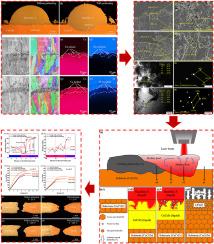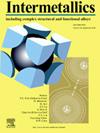Effect of ultra-fine grain zone on mechanical properties of CuCrZr-Hastelloy X bimetallic structure manufactured by laser-directed energy deposition
IF 4.3
2区 材料科学
Q2 CHEMISTRY, PHYSICAL
引用次数: 0
Abstract
In this study, CuCrZr-Hastelloy X bimetallic structure featuring an ultra-fine grain zone (UFGZ) near the interface were fabricated by laser-directed energy deposition (L-DED). Samples with UFGZ were obtained with 300 °C preheating, whereas samples without preheating did not contain UFGZ. The microstructures and mechanical properties of samples with and without UFGZ were compared. The formation of UFGZ was attributed to the presence of a spherical phase near the interface, which was identified as Ni (Fe, Cr, Mo). Due to the higher melting point of Hastelloy X compared to CuCrZr, Ni elements mixed into CuCrZr with the flow of the molten pool, solidified first, and served as substrates for the heterogeneous nucleation, ultimately promoting the formation of UFGZ. With 300 °C preheating, the hardness of CuCrZr near the interface increased from 115.07 HV to 148.51 HV due to the presence of UFGZ. And the hardness gap near the interface decreased from 172.58 HV to 147.19 HV, which improved the uniformity of mechanical properties. Moreover, the nanoindentation tests results that UFGZ increased the hardness of the zone near the interface from 1.42 GPa to 1.72 GPa. Tensile test results indicated that the UFGZ altered the fracture mode from brittle to ductile. Samples with UFGZ exhibited ductile fracture, while those without UFGZ exhibited brittle fracture. At room temperature, the tensile strength of samples with UFGZ increased from 298.44 MPa to 347.05 MPa. For tests conducted at 400 °C, the tensile strength increased from 165.12 MPa to 229.53 MPa. This enhancement indicated that UFGZ could improve the strength and toughness of the interface, thereby enhancing the interfacial bonding strength. This study is of great significance for improving the interfacial bonding strength of CuCrZr-Hastelloy X bimetallic structures.

超细晶粒区对激光定向能沉积制造的 CuCrZr-Hastelloy X 双金属结构机械性能的影响
在这项研究中,通过激光能量沉积(L-DED)制备了在界面附近具有超细晶粒区(UFGZ)的 CuCrZr-Hastelloy X 双金属结构。含有 UFGZ 的样品是在 300 ℃ 预热后获得的,而没有预热的样品则不含 UFGZ。比较了含 UFGZ 和不含 UFGZ 样品的微观结构和机械性能。UFGZ 的形成归因于界面附近球形相的存在,经鉴定为 Ni(Fe、Cr、Mo)。由于哈氏合金 X 的熔点比 CuCrZr 高,镍元素随熔池流动混入 CuCrZr 中,首先凝固,成为异质成核的基底,最终促进了 UFGZ 的形成。预热 300 °C,由于 UFGZ 的存在,界面附近 CuCrZr 的硬度从 115.07 HV 上升到 148.51 HV。界面附近的硬度间隙从 172.58 HV 降至 147.19 HV,从而改善了机械性能的均匀性。此外,纳米压痕测试结果表明,UFGZ 使界面附近区域的硬度从 1.42 GPa 提高到 1.72 GPa。拉伸测试结果表明,UFGZ 使断裂模式从脆性转变为韧性。有 UFGZ 的样品表现出韧性断裂,而没有 UFGZ 的样品则表现出脆性断裂。在室温下,含有 UFGZ 的样品的抗拉强度从 298.44 兆帕增加到 347.05 兆帕。在 400 °C 下进行的测试中,抗拉强度从 165.12 兆帕增加到 229.53 兆帕。这一提高表明 UFGZ 可以改善界面的强度和韧性,从而提高界面粘接强度。这项研究对于提高 CuCrZr-Hastelloy X 双金属结构的界面结合强度具有重要意义。
本文章由计算机程序翻译,如有差异,请以英文原文为准。
求助全文
约1分钟内获得全文
求助全文
来源期刊

Intermetallics
工程技术-材料科学:综合
CiteScore
7.80
自引率
9.10%
发文量
291
审稿时长
37 days
期刊介绍:
This journal is a platform for publishing innovative research and overviews for advancing our understanding of the structure, property, and functionality of complex metallic alloys, including intermetallics, metallic glasses, and high entropy alloys.
The journal reports the science and engineering of metallic materials in the following aspects:
Theories and experiments which address the relationship between property and structure in all length scales.
Physical modeling and numerical simulations which provide a comprehensive understanding of experimental observations.
Stimulated methodologies to characterize the structure and chemistry of materials that correlate the properties.
Technological applications resulting from the understanding of property-structure relationship in materials.
Novel and cutting-edge results warranting rapid communication.
The journal also publishes special issues on selected topics and overviews by invitation only.
 求助内容:
求助内容: 应助结果提醒方式:
应助结果提醒方式:


